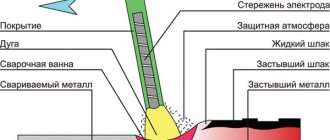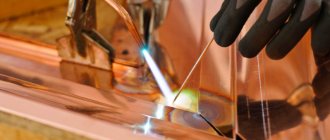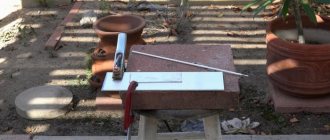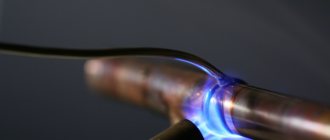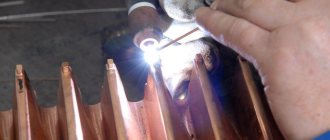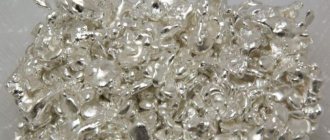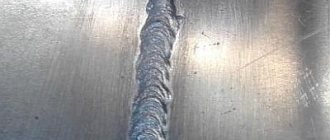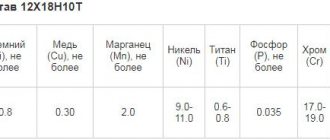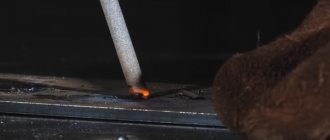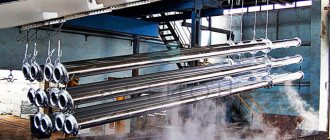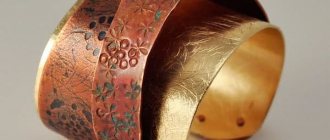The influence of the characteristics of copper on the choice of method for welding it with steel
The choice of welding technology is influenced by the following features of copper:
- High thermal conductivity makes spot heating difficult.
- Rapid oxidation provokes clogging of the weld metal , making it heterogeneous and less durable.
- Copper, when melted, absorbs a large amount of hydrogen , leading to the formation of defects in the weld.
- The strong spreadability of molten copper makes it necessary to weld in the lower position using shims.
- The weldability of copper is greatly influenced by the qualitative and quantitative composition of the impurities included in its composition.
Argon arc welding
Welding occurs using an electric arc in argon, i.e. in an inert environment, using consumable or non-consumable electrodes. A tungsten electrode is most often used as a non-consumable electrode. The additive is supplied to the arc zone from the outside and is not connected to the electrical circuit. Tig welding is usually used to join small products.
The quality of the welded joint depends on the degree of penetration of the steel and will be more acceptable with as little steel as possible in the resulting weld. This is achieved by correctly adjusting the heating and controlling the melting of both metals: the high temperature of the arc is concentrated on the copper, and the steel is heated and melted thanks to the thermal energy coming from the resulting weld pool.
Taking this feature into account for welding copper with thick iron, preheating is not performed. In this case, it is better to perform welding using flux. To prevent the leakage of liquid metal, with this approach, appropriate limiters are used on the copper side.
When using a non-consumable electrode, direct current of straight polarity and pure argon without impurities are used. Material thicker than 4 mm is welded after preheating to 800°C. It is better to weld by tilting the electrode towards the area to be welded by 85-90°, while the filler wire should be tilted by 15-20°, and the electrode extension should be maintained by 5-10 mm. It is also very important to choose the correct filler material. Typically, various copper alloys are used.
Is it possible to weld copper with steel?
weld.in.ua/forum/archive/index.php/t-90.html Below in the text.
I quote: “Welding steel with copper and its alloys.
In equilibrium at room temperature, copper dissolves in alpha-Fe in an amount of up to 0.3%, and iron in copper in an amount of up to 0.2%. Brittle intermetallic compounds are not formed. Due to high cooling rates during welding, a supersaturated solid solution of copper and iron is formed in the transition layer, but at a content of up to 2-2.5% Fe, structurally free iron is not detected. The fusion boundary between steel and copper is sharp, with inclusions of a phase enriched in iron of various sizes. On the side of the steel adjacent to the seam, grain size
increases within a zone 1.5-2.5 mm wide. The microhardness of the fusion zone reaches 580-620 kgf/mm2.
The presence of carbon in steel worsens the mutual solubility of iron and copper, while manganese and silicon improve it. Manganese reduces the critical point A3 and expands the region of the a-solid solution, in which copper dissolves in a much larger amount, and silicon deoxidizes the weld pool and strengthens the grains of the solid solution.
Difficulties in welding and surfacing copper on steel are associated with its physical and chemical properties, the high affinity of copper for oxygen, the low melting point of copper, significant absorption of gases by liquid copper, different values of the coefficients of thermal conductivity, linear expansion, etc.
(One of the main possible defects during welding should be considered the formation of cracks in the steel under the copper layer, filled with copper or its alloys. This phenomenon is explained by the wedging effect of liquid copper penetrating into microtears in the steel along the grain boundaries under the simultaneous action of thermal tensile stresses.
In carbon and low-alloy steels (StZ, 10KhSND, etc.) there are few cracks and their sizes are small, but in steels that have an austenitic structure, in particular type 18-8, the number and size of cracks increase sharply. For steels of type 18-8, an effective barrier to these cracks is the introduction of a ferrite phase. When the ferrite content is over 30% in steel type 18-8, copper penetration into the steel is not observed; this is explained by the fact that ferrite is not wetted by copper and copper penetration into microtears does not occur.
To reduce the risk of the formation of these cracks, it is recommended to weld at a minimum heat input and use nickel alloy MNZh 5-1 or bronze BrAMts 9-2 as a filler metal. The presence of nickel and aluminum reduces the activity of liquid metal in micro-tears on steel, which reduces the risk of deep cracks forming in steel.
Copper, brass and bronze are successfully welded to steel using all fusion welding methods in the same modes as steel parts of the corresponding sections, but the arc from the joint is slightly shifted towards copper or its alloys.
For welding copper, bronze BrAMts 9-2, BrKMts 3-1, brass L90 with steels like StZsp; St4sp; 10; 09G2 is used: a) for manual welding - electrodes with a Komsomolets type coating; b) for submerged arc welding - OSTS-45, AN-26, etc. fluxes and wire grades Ml, M2 and BrKMts 3-1, etc.; c) for welding in an inert shielding gas environment - wire grades BrKMts 3-1, BrAMts 9-2, MNZh 5-1. In some cases, preheating of the product is necessary.
The MNZh 5-1 alloy is welded with carbon and low-alloy steels using electrodes with a rod made of the MNZH 5-1 alloy with a ZT coating, and when welding under the OSTS-45 submerged arc or in shielding gases - with an electrode wire of the MNZH 5-1 grade.
When welding, the uniform strength of the welded joint (for non-ferrous metal) is ensured under the action of a static load. Welded joints have satisfactory ductility. Thus, for joining copper MZr or alloy MNZh 5-1 with steel St4sp during manual welding, the bending angle is 40-85 degrees, and with argon arc 110-180 degrees.
The higher quality of welded joints during argon arc welding with MNZh 5-1 alloys is explained by the fact that in this case the iron content in the weld metal does not exceed 8-10%, and during manual welding it reaches 50-55%.
Optimal conditions for surfacing copper on steel require that there is no melting of the steel, that it is well wetted (for this, its temperature exceeds 1100 degrees C) and the duration of contact of copper with steel at this temperature is at least 0.01-0.015 s.
To join copper and its alloys to steel, it is recommended to use argon arc welding with a tungsten electrode, and for surfacing non-ferrous metals on steel - plasma jet surfacing with a current-carrying filler wire. Welded joints have fairly high fatigue strength.
Welding steel with titanium. One of the main tasks when welding titanium with steels is the selection of welding materials, methods and welding modes in which the formation of brittle intermetallic phases FeTi and Fe2Ti would be prevented or sharply suppressed.
Direct welding of titanium to steel does not give positive results. Practical applications include welding in argon with a tungsten electrode and welding through intermediate inserts. Good results were obtained using a combined insert consisting of technical tantalum (sigmaB = 70 kgf/mm2) and heat-treatable bronze BrB2.
Bronze is welded to carbon or austenitic steel by argon arc welding with a non-consumable electrode, and tantalum to titanium is welded in chambers with a controlled atmosphere. The tensile strength of the joint in bronze is 49 kgf/mm2, when hardening bronze it is 60.5 kgf/mm2 (quenching before welding).
Combined inserts made of BrB2 bronze and niobium are used for argon arc welding with a tungsten electrode in a chamber with a controlled atmosphere of titanium OT4-1 with a thickness of 0.8 and 2 mm. The strength of the connection with a thickness of 0.8 mm sigmaв = 53 - 66 kgf/mm2, bending angle 72-180 degrees; with a thickness of 2 mm sigma = 40 - 45 kgf/mm2, bending angle 41-61 degrees.” end of quote.
Carbon electrode welding
This type of welding does not guarantee a high-quality connection, so it is justified to use carbon electrodes when the copper thickness is small. For thicknesses greater than 15 mm, it is more appropriate to use graphite electrodes.
The work is performed with direct current of straight polarity and is carried out with a long arc in order to avoid undesirable effects on the quality of the released carbon monoxide. Maintain a distance from the filler material to the bath of 5 mm, without immersing it in the bath, at an angle of 30° to the product. The angle of the electrode to the working surface is 70-90°.
It is necessary to use an additive material with phosphorus, and often flux. A layer of flux is applied to the edges to be welded, pre-treated with liquid glass, and dried well.
Parts made of very thin copper are welded with a carbon arc . If it is necessary to weld larger parts, it is also permissible to use a carbon electrode, but it is necessary to use a filler material, which includes boric anhydride, boric acid, and borax. The same composition can be coated on electrodes.
He who doesn't work doesn't make mistakes
For soldering, the tin must reach the desired consistency - similar to water. Then the seam turns out to be of high quality, even and long-lasting.
Mistakes in achieving a good result are:
- the soldering iron has not reached the required temperature;
- poor heating of the parts being soldered. If they are large, then this can be done using a gas burner or on an electric stove;
- incorrect choice of flux, which cannot dissolve the oxide or fatty film on the metal.
All the above-described features must be observed when soldering stainless steel with tin. After finishing work, the connected surfaces should be washed with soap and water. The fact is that the acids used in the process are quite aggressive, they accelerate the destruction and corrosion of the metal, and soap neutralizes them.
Tips in the article “How an electronic dynamometer works” here.
Soldering stainless steel in the video:
Any connection of two metal parts is a priori not a simple procedure. Soldering stainless steel with copper refers to this type of procedure. Working with stainless steel is even more difficult than with other types of materials, since it is quite difficult to melt and combines very poorly with other materials. Therefore, to solder stainless steel parts, you need to use proven methods that have been proven over the years. When soldering any other material, as a rule, no problems arise, but not with stainless steel.
The entire soldering process is clearly regulated by state standards, however, there is one unusual feature. Each type of metal is connected differently to a particular material; accordingly, for each type you need to use different solder and flux, which will be selected exclusively for this material. But if you need to connect non-homogeneous (different) metals, you need to use fairly rare, highly specialized consumables.
This type of stainless steel soldering is widely used both in large industries and in domestic settings. It can be used to create sealed containers, solder copper parts, etc. This soldering method is not as common as others, but you still need to know how to do it and all its features.
Gas welding
Gas welding is widely used in repair work and in the manufacture of thin-walled products made of steel and non-ferrous alloys. Gas welding produces the same types of welded joints as electric arc welding. A special feature of the process is that, under the influence of a stream of oxygen, the gas is heated to a temperature sufficient for melting.
Stages of gas welding of copper:
- Preparatory stage . Cleaning the edges of parts to be welded, aligning product components and fixing parts with tacks. The length of the tacks and their location are determined by the thickness of the copper - from 4-6 mm, the tacks are located at a distance of 70–110 mm from each other, and with a copper thickness of up to 15-25 mm, with a distance between them of up to 450–550 mm.
- Correct installation of components of the manufactured structure . For high-quality welding, installation occurs with a slight inclination to the horizontal (about 15 degrees).
- Selecting the welding mode . The mode is determined by the thickness of the parts being welded. With a thickness of 3–4 mm, a power of 150–175 l/h per 1 mm of thickness is selected, and with a thickness of 8 to 10 mm, the burner power is selected at the rate of 175–230 l/h per 1 mm.
- Welding process.
- The final stage . Consists of forging the seam and cleaning it from flux residues. This is done with nitric or sulfuric acid, followed by removal of acid residues with water.
How to connect copper pipes with and without soldering
Even taking into account the fact that polymer pipes are being used more and more often, metal products are still enjoying considerable success. Typically, the metal used is copper, brass and steel. Copper is superior in terms of resistance to corrosion and high temperatures. Actually, the connection of copper pipes will be discussed in this article.
Even though copper pipes are expensive, taking into account all the characteristics of the material, their use is quite justified.
First of all, before connecting copper pipes, you should decide how to connect them, by soldering or another method.
Connecting pipes using soldering
Let's consider connecting copper tubes with fittings followed by soldering, which can be low- and high-temperature. In the first method, soldering is carried out at a temperature of 300 ºC. The second method is used when installing systems with high loads for industrial purposes.
Couplings are used as connectors for copper pipes; tin-lead solder and flux are additionally needed.
The pipe soldering technology will be as follows:
- First of all, a pipe of a certain size is cut. This process must be carried out carefully, taking into account the size of the existing fittings.
- The ends of the pipes must be inspected - there should be no defects such as chips, cracks or burrs. If they are not eliminated, there will be problems with the tightness of the connection after all the work is completed.
- After making sure that the ends are clean, you can start connecting. Due to the fact that several pipes will be connected, and they can be of different sections, the fittings must be selected accordingly.
- Next, the end of the pipe and the inner walls of the couplings should be treated with flux, which will degrease the surfaces to obtain the highest quality connection.
- Now the end of the pipe is threaded into the copper tube connector and heated. It must be selected so that the cross-section is 1-1.5 cm larger than the cross-section of the pipe. The pipes are heated with a gas burner. The gap between the pipe and the coupling is filled with molten solder. Currently, you can find any type of solder on the market to suit your needs, so there should not be any problems with the choice.
- After the solder is evenly distributed around the circumference, the parts to be joined must be left until it has completely hardened.
- At the final stage, you need to check the connectors for the copper pipes and the entire system by running water into it. At this moment, not only the system will be checked, but it will also be cleaned of flux residues, which over time can cause metal corrosion.
Sealed joining of copper pipes without soldering
Additionally, it is worth noting that, despite the fact that connecting pipes by soldering is considered the most reliable method in most cases, there are still situations when it is not possible to use this method. In such cases, you can resort to connecting copper tubes without soldering. Special fittings will be required that will ensure a reliable connection due to the clamping effect that is formed by the threaded connection.
In this case, the connection is made in the following sequence:
- First, the fittings are disconnected, which often have two components.
- One of the elements is put on the pipe. As a rule, this is a nut and a clamping ring.
- Next, thread the pipe into the fitting and tighten the nut.
Typically, such fittings are equipped with detailed instructions, which must be followed, otherwise the work performed will be of poor quality.
It is worth noting that before connecting copper tubes without soldering, you should be aware of all the risks, since it is quite difficult to obtain a high-quality connection. Minimal distortions of the connected parts are not allowed at all, otherwise the technology is grossly violated. To make the threaded connection extremely tight, it is advisable to additionally seal it with special threads. At the same time, it is worth making sure that they do not end up on the inside of the pipe, since subsequently water may not pass through the system properly.
Mandatory connection rules
For any type of connection, the list of work performed will look like this:
- The connected pipes must be made of the same metal. If you are going to connect a copper pipe with a pipe made of any other material, you must decide on the desired connection method. For example, the soldering method cannot be used to join pipes made of copper and polyvinyl chloride.
- When connecting a copper pipe to a steel pipe, the copper pipe should be placed after the steel pipe.
- When tightening a threaded connection, you need to be extremely careful, especially if you have pipes with thin walls.
- To correctly determine the amount of solder required, the piece of wire must have the circumference of the pipe being soldered.
- A special burner is best suited for heating pipes. You can, of course, use a simple blowtorch, but in this case you need to be prepared that the joint will overheat and the entire work process will become somewhat more complicated.
- It's no secret that copper pipes are a rather expensive material. In this regard, even before carrying out the work, it would not be superfluous to make preliminary calculations of the volume of required material. At the same time, remember that all connecting parts also have their own dimensions, so they must be taken into account.
In conclusion, it would not be amiss to note that connecting copper pipes is technologically a process of medium complexity. If you are doing this kind of work for the first time, then you need to be prepared for the fact that some nuances may arise. To understand the process and get as much insight as possible about it, it would be a good idea to get advice from professional workers, or at least get acquainted with the available video materials.
Source: https://trubaspec.com/soedinenie-trub/kak-vypolnyaetsya-soedinenie-mednykh-trub-s-paykoy-i-bez-neye.html
Other types of welding
Let's look at less common types of welding:
- Friction welding allows you to obtain welded joints with strength at the level of the base material.
- Explosion welding produces a high-strength connection . The method is used to produce layered sheets and tapes.
- Roll welding is used to produce bimetallic sheets and steel + copper strips . Usually the connection is not inferior in strength to the base metal.
- Resistance welding provides intense heat generation in the welding zone and high temperature gradients.
- Ultrasonic welding of small thickness parts . Vibrations are supplied from the copper side.
- Diffusion welding . Provides heat-resistant, vibration-resistant welded joints while maintaining high accuracy of geometric dimensions and shapes of products.
- Fusion welding . A layer of another metal is first fused onto the steel or an intermediate insert is used.
- Electron beam welding . A very promising, but still rarely used technique. This is a relatively safe and environmentally friendly method that almost does not endanger the health of the welder.

